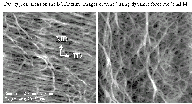
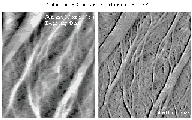
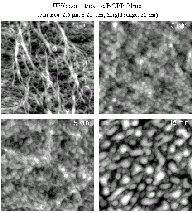
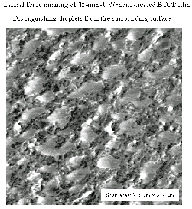
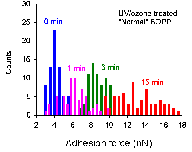
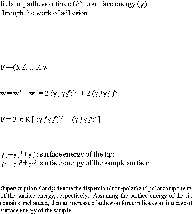

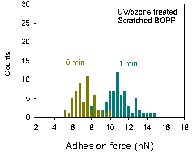
The morphological and energetic changes
on sequentially biaxially-oriented polypropylene (BOPP) films modified by
the exposure of the polymer to ozone in the presence of ultraviolet light (UV/ozone) [1]
as well as localised shear deformation [2] have been studied by using atomic force microscopy (AFM). The original BOPP surface is dominated by a nanometer-scale fiber-like network structure, the co
nfiguration of which was found to be determined by the relationship between the draw ratios used in the bi-directional stretching processes to form the polymer film [3]. For the film fabricated with machine draw (MD) and transverse dr
aw (TD) ratios of 5.2:1 and 9:1, respectively, preferential orientation of fine fibers in the TD direction and larger veins in the MD direction were observed.
Using AFM we were able to examine the changes in morphology and the increase in the adhesion force on UV/ozone treated BOPP films. AFM study revealed that UV/ozone treatment changes the sur
face from the original, fine, fiber-like structure to one displaying the formation of mounds or droplets, which are most likely comprised of short chains of oxidized polymer or low-molecular weight oxidized materials (LMWOM). The size of the mounds incre
ased with increasing treatment time. Lateral force imaging AFM was capable of distinguishing these mounds from the surrounding surface, indicating that the mounds are formed on aggregation of the LMWOM during the UV/ozon
e treatment while the surrounding surface was covered by moderately oxidized materials. A clear increase in adhesion force was observed on the modified polymer film surface. We demonstrated that the increase in the adhe
sion force indicates an increase in the surface energy.
Localized shear deformation of BOPP film using a stylus results in a reorientation of polymer strands in the shear-force direction. This change in surface structure also resulted in an
increase in the surface energy, which is thought to be caused by an increase in density and closer ordering of the polymer strands on the film surface. We demonstrate that the surface energy of the polymer film can be in
creased either by mechanical scratching of the surface or by adding oxygen-containing chemical functional groups to the surface as in UV/ozone treatments. The increase in surface energy from mechanical scratching of the BOPP surface is comparable to that
seen after one minute of exposure to UV/ozone. Being able to change the local surface energy of a polymer by mechanical scratching without changing the surface energy of the surrounding polymer and without influencing the bulk properties of the polymer
can create local active (high surface energy) sites on surface.

|

|

|

|

|

|

|

|
References:
[1] H.-Y. Nie, M.J. Walzak, B. Berno, and N.S. McIntyre, Appl. Surf. Sci. 144-145, 627 (1999).
[2] H.-Y. Nie, M.J. Walzak, B. Berno, and N.S. McIntyre, Langmuir 15, 6484 (1999).
[3] H.-Y. Nie, M.J. Walzak, and N.S. McIntyre,
Polymer 41, 2213
(2000).